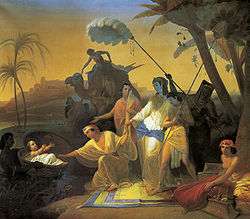Ark of bulrushes

Theark of bulrushes(Hebrew:תבת גמא,romanized:têḇaṯ gōme) was a container which, according to the episode known as thefinding of Mosesin the biblicalBook of Exodus,carried the infant Moses.
The ark, containing the three-month-old baby Moses, was placed in reeds by the river bank[1](presumably theNile) to protect him from the Egyptian mandate to drown every maleHebrewchild,[2]and discovered there by Pharaoh's daughter.
Analysis[edit]
The ark is described as being daubed with asphalt and pitch, and the English word "ark" is a translation of theHebrewתֵּבָה (tevah,modernteiva), the same word used forNoah's Ark.According toIrving Finkel,the wordtevahis nearly identical to the Babylonian word for an oblong boat (ṭubbû), especially given that "v" and "b" are the same letter in Hebrew:bet(ב).[3]
The "bulrushes"(Hebrew:גֹּ֫מֶאgome) were likely to have been papyrus stalks (Cyperus papyrus), daubed withbitumenandpitch.
A similar but earlier story is told ofSargon of Akkad.[4]
See also[edit]
References[edit]
- ^Exodus 2:2–3
- ^Exodus 1:22
- ^Finkel 2014,chpt.14.
- ^.New International Encyclopedia.1905.
Bibliography[edit]
- Finkel, Irving L.(2014),The Ark Before Noah: Decoding the Story of the Flood,Hodder & Stoughton,ISBN9781444757071
